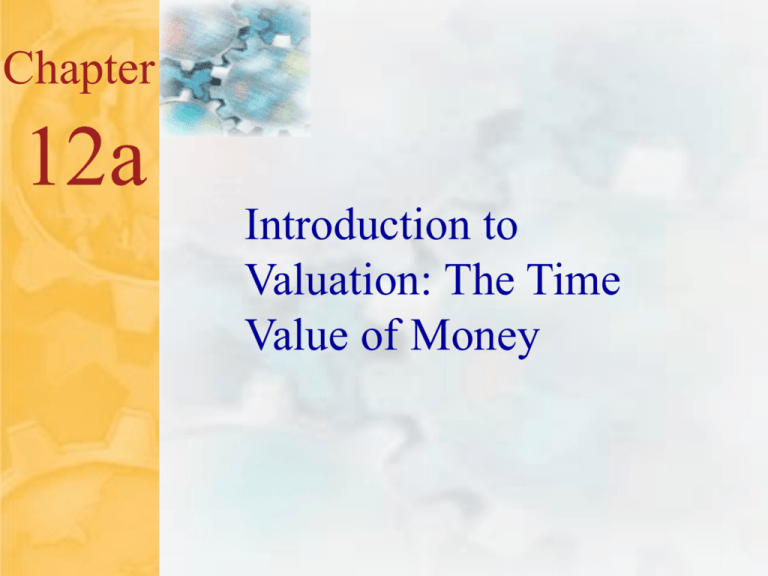
4.0
Chapter
12a
Introduction to
Valuation: The Time
Value of Money
McGraw-Hill/Irwin
©2001 The McGraw-Hill Companies All Rights Reserved
4.1
Basic Definitions
Value – earlier money on a time line
Future Value – later money on a time line
Interest rate – “exchange rate” between earlier
money and later money
Present
Discount rate
Cost of capital
Opportunity cost of capital
Required return
McGraw-Hill/Irwin
©2001 The McGraw-Hill Companies All Rights Reserved
4.2
Future Values: General Formula
FV
= PV(1 + r)t
FV = future value
PV = present value
r = period interest rate, expressed as a decimal
T = number of periods
Future
value interest factor = (1 + r)t
McGraw-Hill/Irwin
©2001 The McGraw-Hill Companies All Rights Reserved
4.3
Future Values
Suppose
you invest $1000 for one year at 5%
per year. What is the future value in one year?
Suppose
you leave the money in for another
year. How much will you have two years from
now?
McGraw-Hill/Irwin
©2001 The McGraw-Hill Companies All Rights Reserved
4.4
Effects of Compounding
Simple
interest
Compound interest
Consider the previous example
FV with simple interest = 1000 + 50 + 50 = 1100
FV with compound interest = 1102.50
The extra 2.50 comes from the interest of .05(50) =
2.50 earned on the first interest payment
McGraw-Hill/Irwin
©2001 The McGraw-Hill Companies All Rights Reserved
4.5
Future Value as a General Growth
Formula
Suppose
your company expects to increase unit
sales of widgets by 15% per year for the next 5
years. If you currently sell 3 million widgets in
one year, how many widgets do you expect to
sell in 5 years?
McGraw-Hill/Irwin
©2001 The McGraw-Hill Companies All Rights Reserved
4.6
Quick Quiz – Part 1
What
is the difference between simple interest
and compound interest?
Suppose you have $500 to invest and you
believe that you can earn 8% per year over the
next 15 years.
How much would you have at the end of 15 years
using compound interest?
How much would you have using simple interest?
McGraw-Hill/Irwin
©2001 The McGraw-Hill Companies All Rights Reserved
4.7
Present Values
How much do I have to invest today to have some
amount in the future?
FV = PV(1 + r)t
Rearrange to solve for PV = FV / (1 + r)t
When we talk about discounting, we mean finding the
present value of some future amount.
When we talk about the “value” of something, we are
talking about the present value unless we specifically
indicate that we want the future value.
McGraw-Hill/Irwin
©2001 The McGraw-Hill Companies All Rights Reserved
Present Value – One Period
Example
4.8
Suppose
you need $10,000 in one year for the
down payment on a new car. If you can earn
7% annually, how much do you need to invest
today?
McGraw-Hill/Irwin
©2001 The McGraw-Hill Companies All Rights Reserved
4.9
Present Values – Example 2
You
want to begin saving for you daughter’s
college education and you estimate that she
will need $150,000 in 17 years. If you feel
confident that you can earn 8% per year, how
much do you need to invest today?
McGraw-Hill/Irwin
©2001 The McGraw-Hill Companies All Rights Reserved
Present Value – Important
Relationship I
4.10
a given interest rate – the longer the time
period, the lower the present value
For
What is the present value of $500 to be received in 5
years? 10 years? The discount rate is 10%
5 years: PV = 310.46
10 years: PV = 192.77
McGraw-Hill/Irwin
©2001 The McGraw-Hill Companies All Rights Reserved
Present Value – Important
Relationship II
4.11
a given time period – the higher the interest
rate, the smaller the present value
For
What is the present value of $500 received in 5 years
if the interest rate is 10%? 15%?
Rate = 10%: PV = 310.46
Rate = 15%; PV = 248.58
McGraw-Hill/Irwin
©2001 The McGraw-Hill Companies All Rights Reserved





